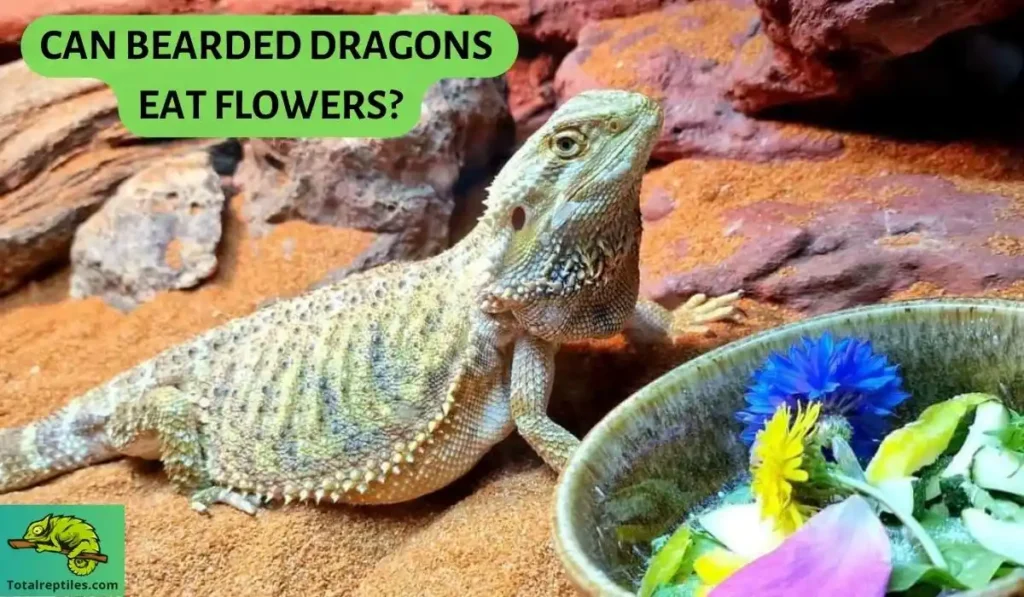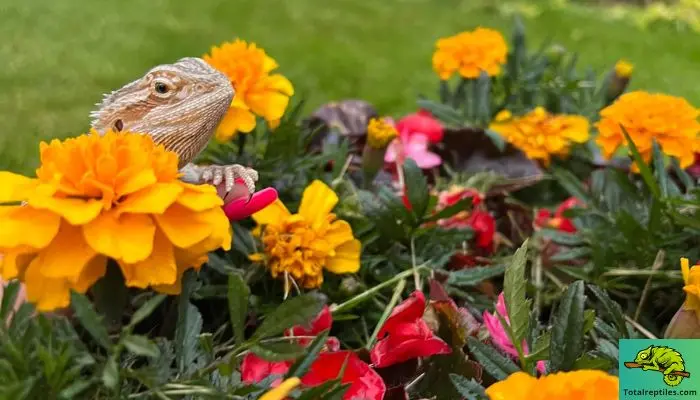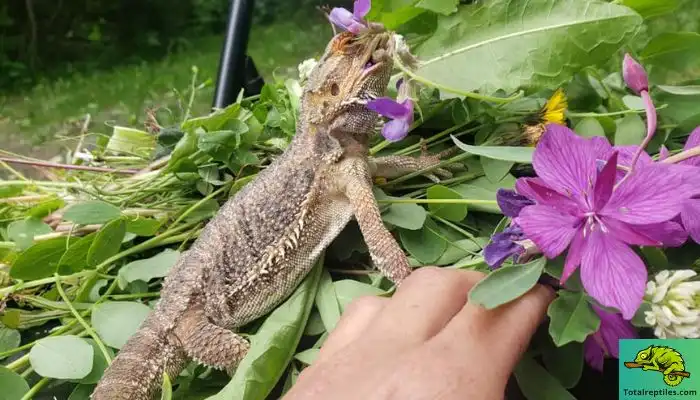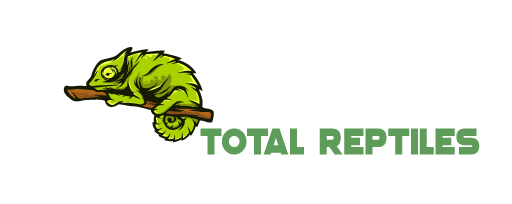In a word, yes, they can eat flowers. But not all types.
Bearded dragons, those charming creatures with spiky demeanor, hold a hidden fondness for the delicate beauty of flowers. These omnivorous reptiles relish both plant-based and protein-rich meals.
While flowers make for a delightful occasional treat, it’s crucial to discern which types are safe for your scaly companion.
As you curate their diverse diet, incorporating a medley of plants, greens, and even the occasional meat or mice, exploring the world of blossoms can add a touch of vibrancy to their culinary experience.
So, let’s embark on a floral journey together, unraveling the petals of knowledge and discovering which flowers can be relished by these captivating bearded dragons.

What Flowers Can Bearded Dragons Eat?
It’s crucial to exercise caution and identify which flowers are safe for consumption.
When selecting flowers for your bearded dragon, choosing those free from pesticides, herbicides, harmful chemicals, fertilizers, or other additives is essential.
Here, we’ll explore some flower options that can be enjoyed by these charming reptiles, ensuring both their taste buds and health are satisfied:
- Hibiscus: These vibrant, trumpet-shaped blooms are visually appealing and packed with essential nutrients. Hibiscus flowers contain calcium, iron, vitamin C, and antioxidants, making them a wholesome treat for your bearded dragon.
- Rose: Apart from being a symbol of love, roses can also be a delightful addition to your bearded dragon’s diet. Ensure the roses are free from pesticides and thorns before offering them to your pet. Roses are rich in vitamin C and provide a mild, enticing flavor.
- Marigolds: With their bright orange and yellow petals, marigolds provide a visually striking option for your bearded dragon’s menu. Marigold flowers contain lutein, which promotes eye health and can contribute to the overall well-being of your scaly companion.
- Nasturtium: These vibrant blossoms are pleasing to the eye and offer a peppery taste that some bearded dragons find irresistible. Nasturtium flowers are an excellent source of vitamin C and have natural antimicrobial properties.
Note: While these flowers are generally safe for bearded dragons, moderation is a must.

Treat flowers as occasional additions to their diet rather than a staple food source. Always gradually introduce new flowers and monitor your pet’s reaction to avoid adverse effects.
For the nutritional value of edible flowers for bearded dragons
| Flower | Calcium (mg) | Vitamin C (mg) | Iron (mg) | Antioxidants |
| Hibiscus | 29 | 18 | 1.2 | High |
| Rose | 14 | 5 | 0.8 | Moderate |
| Marigold | 8 | 6 | 0.6 | Moderate |
| Nasturtium | 12 | 10 | 0.5 | High |
Flowers to Avoid Feeding Bearded Dragons
While incorporating flowers into your bearded dragon’s diet can be a delightful experience, it’s crucial to be aware of the flowers that can be harmful or toxic to these scaly companions.
Some flowers may contain substances that can pose significant risks to their health. To ensure the well-being of your bearded dragon, it’s essential to avoid feeding them the following flowers:
- Daffodils: These cheerful spring flowers contain toxic alkaloids like lycorine, which can harm bearded dragons if ingested. Symptoms of daffodil poisoning may include vomiting and diarrhea.
- Tulips: While tulips can add a burst of color to any garden, they contain toxins called tulipalin A and B. Ingesting tulips can lead to gastrointestinal upset in bearded dragons.
- Lilies: Although lilies are often admired for their elegance and fragrance, they can be highly toxic to bearded dragons. Lilies are poisonous plants that contain substances that can damage kidneys and even cause organ failure.
- Azaleas and Rhododendrons: These popular ornamental flowers contain grayanotoxins, which can be highly toxic to bearded dragons. If ingested, these flowers can cause symptoms such as drooling, loss of appetite, weakness, and potentially life-threatening cardiac problems.
- Oleander: Well-known for its beautiful blooms, oleander contains cardiac glycosides that can be fatal if ingested by bearded dragons. Symptoms of oleander poisoning include gastrointestinal distress, irregular heart rate, and even death.
If you suspect your bearded dragon has ingested a toxic flower or is exhibiting any concerning symptoms, it’s crucial to seek immediate veterinary assistance.
A pet’s well-being and recovery can greatly benefit from prompt medical attention.
Note: Remember that this list is not exhaustive. Other flowers may be toxic to bearded dragons. It is best to avoid offering unfamiliar flowers when in doubt.
It’s best to stick to the list of safe flowers we mention above and prioritize their health above all else.
Preparing Flowers for Bearded Dragons – Step By Step
Here’s a step-by-step guide on how to prepare flowers for your bearded dragon:

Step 1: Selection
Choose fresh and organic roses, marigolds, hibiscus, or other edible flowers free from pesticides, herbicides, and other harmful chemicals. These flowers are generally safe for bearded dragons and offer nutritional benefits.
Step 2: Washing
Thoroughly rinse the flowers with water to remove any dirt. Gently pat them dry with a paper towel or allow them to air dry.
Step 3: Removal of Stems and Thorns
Trim off the stems and any thorns from roses, as they can pose a choking hazard or cause injury to your bearded dragon.
For marigolds and hibiscus, remove any tough stems that may be difficult for your pet to chew.
Step 4: Petal Separation
Gently separate the petals from the flower’s core. Bearded dragons may have an easier time consuming the soft petals rather than the tougher parts of the flowers.
Step 5: Presentation
Arrange the prepared rose, marigold, and hibiscus petals in a clean feeding dish, or scatter them around your bearded dragon’s enclosure.
This provides mental stimulation and mimics their natural foraging behavior.
Caution: Always remember to introduce new flowers gradually and monitor your bearded dragon for any adverse reactions.
Can Bearded Dragons Eat Buttercups?
No, buttercups are not suitable for bearded dragons as they are toxic to these scaly creatures.
While humans may not experience any adverse effects from buttercup consumption, these vibrant yellow flowers can spell trouble for our bearded friends.
Buttercups contain toxins that can have severe consequences for bearded dragons if ingested. These toxins can result in vomiting, diarrhea, and seizures.
As herbivores, bearded dragons eat mainly vegetables, fruits, insects, and appropriately prepared meats.
To ensure the well-being of your bearded dragon, it is advisable to avoid feeding them buttercups or any other toxic plants.
Can Bearded Dragons Eat Hostas?
Yes, bearded dragons can enjoy hostas as part of their diet, but it’s important to approach it with caution and moderation.
Hostas can be a nutritious addition to their leafy green options, providing variety and essential nutrients. But, it’s crucial to ensure that the hostas have not been exposed to pesticides or other harmful chemicals.
When feeding hostas to your bearded dragon, choose organically grown or pesticide-free plants to minimize any potential risks. Thoroughly wash the hostas to remove any dirt or residue before offering them to your dragon.
Can Bearded Dragons Eat Petunias?
Yes, bearded dragons can enjoy petunias as a part of their diet.
These vibrant flowers not only add variety to their meals but also provide essential vitamins and minerals. Petunias are rich in vitamins A and C, contributing to healthy and vibrant skin in bearded dragons.
It is important to exercise caution and ensure that the petunias you offer have not been treated with pesticide sprays or other chemicals.
To minimize potential risks, choose organically grown or pesticide-free petunias whenever possible.
FAQ’s
Q: Can Bearded Dragons Eat Orchids?
A: Yes, they can. Orchids provide some health benefits for bearded dragons, making them a suitable addition to their diet.
Q: Can Bearded Dragons Eat Lilacs?
A: Yes, they can. Lilacs are safe for bearded dragons to eat and offer a pleasant variety in their food choices.
Q: Can Bearded Dragons Eat Lilies?
A: No, they can’t. Lilies can be highly toxic to bearded dragons and should be strictly avoided to prevent any harm or illness.
Q: Can Bearded Dragons Eat Chamomile?
A: Yes, they can. Bearded dragons can also enjoy English chamomile (Roman chamomile) as an occasional treat rich in vitamins and minerals, promoting their overall health and well-being.
Conclusion
In summary, bearded dragons eat flowers depending on the specific variant. While some flowers like marigold, rose, orchids, lilacs, and chamomile can be safely enjoyed by bearded dragons, others like lilies should be strictly avoided due to their toxicity.
Remember to introduce new flowers gradually and monitor your bearded dragon’s response.
By offering the right flowers in moderation, you can add a touch of color and variety to their diet while keeping them healthy and happy.

